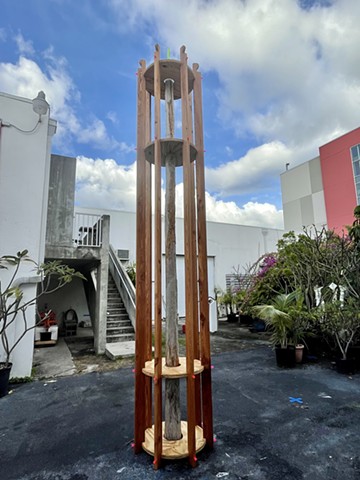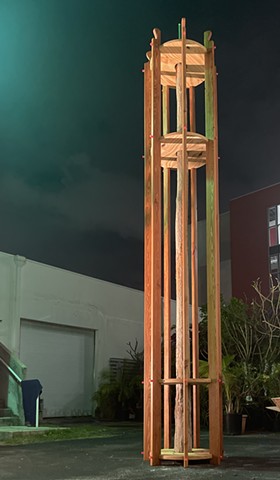Reconstructed Dade County Pine (Totem)
First exhibited at The BluPrnt show, curated by Robert Chambers, at Bridge Red Project Space, Miami, FL
11/20/22-1/8/22
Reconstructed Dade County Pine Tree (Totem)
Salvaged old growth Dade County Pine (pinus elliotii va. densa), CDX plywood, neon acrylic
36"d x 196" h
2022
Reconstructed Dade County Pine Tree (Totem)
The south Florida Slash Pine tree (pinus elliottii var. densa), commonly referred to as “Dade County Pine” is a dominant species within the pine rockland ecosystem. This critically imperiled habitat is only found in south Florida and a few Caribbean islands, and less than 3% of the original area remains. The lumber of the Dade County pine is exceptionally strong and weather resistant, which made it a choice building material in the early 20th century. The conjunction of technological advancements and the burgeoning south Florida real estate boom made swift work of most of the Dade County pine forests. For millennia indigenous cultures such as the Tequesta, as well as many forms of wildlife, depended on these forests. Today very few (if any) old growth Dade County Pine trees still stand.
The artist, Nick Gilmore, reclaims and collects old growth Dade County pine material and uses it in his myriad projects not only to preserve it and celebrate its physical characteristics, but also to spread awareness of the tree’s significant role in the history of south Florida.
The central trunk in this piece was found already cut into three sections. This tree had been standing dead for many years, slowly eroding the outer layers, leaving only the rock-hard heartwood, before it was cut down and soon after discovered by the artist before it could be hauled off to the landfill. The outer beams of this piece were salvaged from a 1926 Miami house that was demolished in 2021. The union of these two forms of Dade County pine symbolizes the fraught history of our local environment and pays tribute to the role this magnificent tree offers regarding the built and natural environments in this land of tropical paradox.



